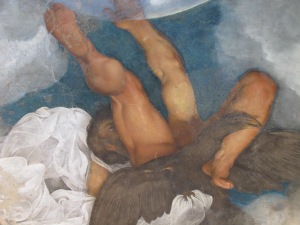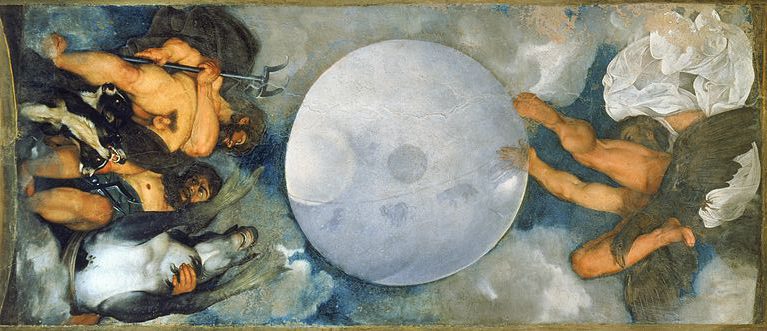This is the continuation of a previous post on our visit to Villa Aurora.
The Principessa led us upstairs to another grand room, where she showed us more wonderful art pieces and described some of the ardors of restoring such an old and historically important residence. We were fascinated. But, we knew the best was yet to come.
After describing the room’s beautiful ceiling, she opened a small door, beyond which was a short corridor with a single small window. I expected her to open a door at the end of the corridor to yet another amazing room, but what awaited us instead was the ceiling of the corridor itself. I found just above my head Caravaggio’s…. most private parts (it is said they are, well, a kind of self portrait).
The ceiling of this tiny room has the only mural that Caravaggio ever painted, executed in oils and measuring only 300 x 152 cm. I knew it was a small painting but was startled not to see it soaring ten feet above me — the mural lay within my reach. Talk about intimate.

The painting is of the gods Jupiter, Neptune, and Pluto. You look up at them while they float above you, looking down. Like the faun that greeted us outside the Villa, these figures don’t have any trousers, though there is a strategically placed eagle.

Jupiter hovers in the air with his eagle and reaches out for a glowing celestial sphere, across which hover some figures of the zodiac.

On the other side of the painting loom Neptune with a strange sea-horse and Pluto with Cerberus, the many-headed dog that guards the gates of the underworld (although this one appears to be a pleasant kind of black and white collie).

This painting was installed for Cardinal del Monte, the prior owner of the house, around 1600. What was a man of the cloth doing with a racy painting by Caravaggio (whose use of prostitutes as models for the Virgin Mary was not well received by the church) depicting three pagan gods and symbols of astrology? And why would he pay Caravaggio to paint the ceiling in this tiny room, as opposed to a room where it could be shown off to the Cardinal’s many visitors?

The answer is interesting. The Cardinal was an avid art collector, a patron to Caravaggio, and a friend of Galileo. He was also an amateur alchemist. Well, this corridor was the Cardinal’s hidden “alchemy room.” His interest in alchemy and astronomy, as well as the the racy nature of this racy painting, meant that the Cardinal wanted this painting in a discrete location, where it would only be shared with a select few. Indeed, the corridor’s single window could be kept shuttered, and its doors locked, so no one could even get an inadvertent glimpse of the painting.
Because of the correlation to alchemy, the ancient gods who stood for the elements air (Jupiter), earth (Pluto), and water (Neptune), also could be interpreted as corresponding to, sulfur, mercury, and salt — important alchemical ingredients. And, the glowing celestial sphere brings in the ideas of fire (the sun) as well as the astrological/astronomical conditions that best supported alchemy experiments.
This is an unusual painting, even for the unconventional Caravaggio, in terms of subject matter and perspective. The cardinal sold the villa to the Ludovisi family in 1621, after which it was remodeled and redecorated — and this unique Caravaggio was lost under coats of paint.
So yes, it truly was an amazing experience to see this “rediscovered” mural hovering just above my head. If you are a Caravaggio lover, this should be on your bucket list!
Our heartfelt thanks go to the gracious hospitality of Principessa Rita for the tour and for permitting us to take the photos used in this blog.
